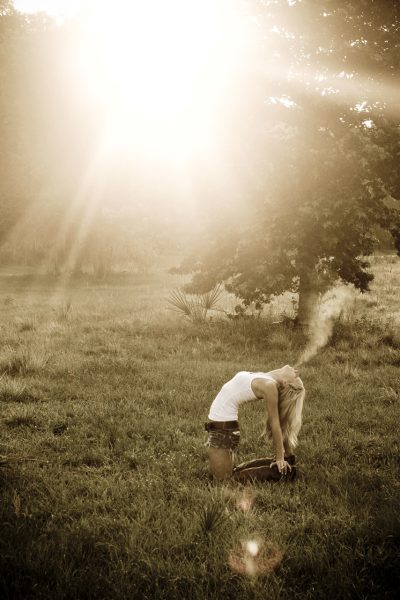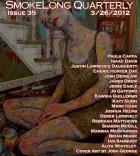Mark, I love the complexity in this brief piece—parallel sets of tensions, two layers of backstory, all working together in a rather sophisticated way. Was the structure of this story an early and planned element, or did it occur more organically, a sort of falling-out in the telling?
Hello Joe, I am a big fan of your stories, so it is twice the mirth that you were the one to select this short.
This story had no planning. It started with a few details that lingered, that annoyed; initial thoughts that invited others. Seemingly unrelated at first, those jumbled observations and phrases were spread around the page, snipped and shuffled, uncovering an interrelatedness that probably existed all along.
I’m always fascinated by the origins of stories. How did the kernel of this story come to be? Is it rooted in your experiences as a visual artist?
The kernel of the story broke when I walked into a museum in New York, to look at a show. I noticed a mother roaming the space with her teenage son. The kid held a camera that looked much larger than he could handle, a hand-me-down from a deceased great uncle perhaps. There was a definite power play between them. The kid used passive aggressiveness and silence to maintain his sovereignty over the camera’s use. The mother—although a Sikorsky type—was being friendly and unruffled by the latent aggression. They were very different, but equally potent with their arsenals. That dynamic had rays. The artwork in the show—none of which relates to the story—was jaded, vacuous, as if slapped together by yawning poseurs. I wasn’t sure if they didn’t give a damn, or if they were just testing the power of the museum perch to let them get away with it. The artist, Ed Ruscha, said that the difference between good and bad art is that when you see good art, you respond: Huh? Wow! And when you see bad art, you respond: Wow! Huh? With that show, all I could come up with was WTF? There were also two hovering security guards. I guess, to protect the artwork, most usefully from being tripped on (step back sir!) One looked like a Bond villain; the other a little more dated: a Jean-Claude Van Damme movie extra (back row left, behind Mr. Vice President) with Ray-Bans and a wiggly earpiece. All of this in a museum! As I sat to write the story that evening, somehow the mother dropped out, the story moved on from one to two kids, then they were adults. Forms of power and powerlessness emerged from the layers.
When I read your story a second time, I wondered if your use of hockey in this story was arbitrary, or if it was a deeper, intentional act; i.e. purposefully choosing it over other sports or competitive activities that may have worked just as well. Being more of a football/baseball guy myself, I had to do a little research on the right wing position, and I see now how it fits. Tell me about your thought process on creating the detail for this important glimpse of backstory.
I often write through a spatial perspective, with storyline emanating from visuals. The sheen of the museum’s honed slab squinted an ice rink; the concrete hairline cracks were skate marks on ice. That must have stayed with me. You were on the money about the right wing position being of importance. The right wing in hockey is usually someone who is fearless enough to slug it out with very physical defenders. Photography also requires fearlessness to aim at someone you don’t know or to shoot near a No Photography sign. A photographer, in order to raise that camera, has to be like a hockey right wing, a gladiator in spurts, which the character in the story could not muster.
To me, there is a certain textural aspect to your story as well, in the way that you weave imagery of control and powerlessness throughout. It works wonderfully, but now I’m going to turn the “control” table on you a bit and act like the performance artist. Since this is a story of a struggle between two brothers, and they are both your creation, choose a side. Right now. No excuses. What’s your first instinct?
Most definitely the photographer is my favorite, he is more screwed up, more unhinged, so a more beloved literary character.
What do you hope 2012 has in store for you as a writer? And beyond writing?
I have been working on a novel for a while, and I have been discarding entire chapters as I get closer and closer to the heart of the story. It feels counterintuitive; shouldn’t the number of written pages increase with time? I seem to be heading toward total erasure. I am wondering if I’ll get there this year. I am also wrapping up a book of short stories.
Beyond writing I have a lot of good hopes for 2012. That partitions in public restrooms get extended all the way to the walls and to the floor, and that leather sandals covered by bunched pants never be seen again. That John McEnroe wins the US Open this year, and that lint fires be taken seriously again, as they once were.
Thank you Joe for those excellent questions. Much appreciation to Tara and Gay, and to Ashley for her smokin’ (Smoking With) companion photograph.



 The core workshop of SmokeLong Fitness is all in writing, so you can take part from anywhere at anytime. We are excited about creating a supportive, consistent and structured environment for flash writers to work on their craft in a community. We are thrilled and proud to say that our workshop participants have won, placed, or been listed in every major flash competition. Community works.
The core workshop of SmokeLong Fitness is all in writing, so you can take part from anywhere at anytime. We are excited about creating a supportive, consistent and structured environment for flash writers to work on their craft in a community. We are thrilled and proud to say that our workshop participants have won, placed, or been listed in every major flash competition. Community works.